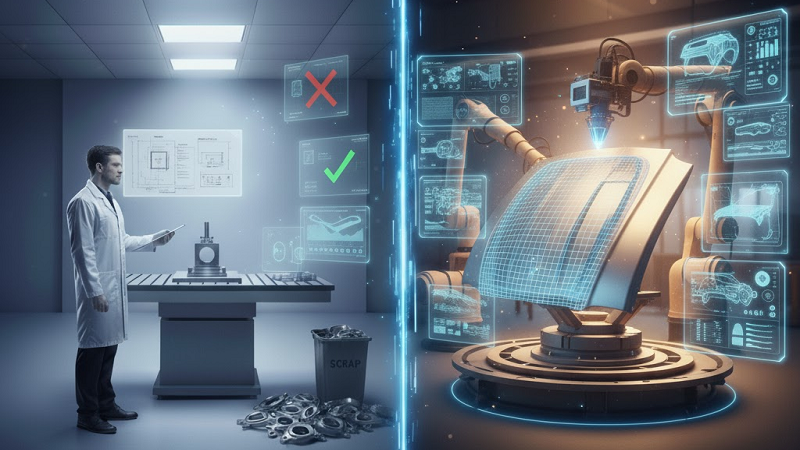AI in Industrial Metrology: From Deterministic Inspection to Adaptive Intelligence
Industrial metrology has always been central to product quality. Precise measurement ensures parts fit, systems perform, and safety standards are met. Today, artificial intelligence (AI) is accelerating that mission, shifting metrology from a deterministic, rule-driven discipline to a data-rich, adaptive ecosystem. AI is changing industrial metrology across the manufacturing lifecycle. What does it means for product quality, throughput, and the competitive landscape?
From Static Checks to Adaptive Measurement
Traditional metrology workflows are typically deterministic: a part is measured according to predefined inspection plans, pass/fail decisions are made against fixed tolerances, and exceptions trigger rework or scrap. This model works well when the production process is stable and variations are limited. But modern manufacturing features more complexity – multi-material assemblies, tighter tolerances, high-mix low-volume runs, adaptive manufacturing processes – so static inspection can become brittle, inefficient, and slow.
AI brings adaptability. Machine learning (ML) models can learn patterns from historical measurement data, machine signals, and contextual metadata (e.g., machine settings, operator, environmental conditions). Instead of rigid plans, AI enables inspection strategies that change dynamically: focusing measurement effort where variation is most likely, adjusting sampling rates, or applying different analysis thresholds based on learned context. That means more meaningful measurements, earlier detection of nonconformance, and fewer wasted cycles on low-risk checks.
Smarter Sensors Provide Richer Data
The rise of smarter sensors – high-resolution vision systems, laser scanners, structured light, and multi-axis CMM probes – generates torrents of high-dimensional data. Raw point clouds, images, thermal maps, and sequence data are expensive to store and tedious to analyze manually. AI excels at extracting signal from such data: convolutional neural networks (CNNs) can find subtle surface defects from images; point-cloud neural networks can detect out-of-spec geometries without exhaustive feature extraction; anomaly-detection models can flag unusual patterns in vibration or acoustic emissions that precede dimensional drift.
The practical outcome: inspection shifts left and becomes continuous. Inline sensors equipped with onboard AI can make near-instant quality inferences on the line, enabling real-time process corrections rather than waiting for end-of-line inspection. Continuous monitoring also builds a richer dataset for downstream analytics and root-cause analysis.
Predictive Quality and Reduced Scrap
One of AI’s most tangible benefits is predictive quality. By correlating measurement outcomes with upstream process parameters (e.g., machine temperatures, tool wear, feed rates), ML models can forecast when a process is likely to produce out-of-tolerance parts. Manufacturers can schedule maintenance, replace tooling preemptively, or adjust process parameters automatically – avoiding batches of bad parts and reducing scrap.
Predictive maintenance and predictive quality are two sides of the same coin: fewer surprises, more predictable yields, and improved overall equipment effectiveness (OEE). For cost-sensitive industries like automotive or aerospace, even modest reductions in scrap or rework translate into significant savings and shorter lead times.
Augmenting Human Expertise – Not Replacing It
A common worry is that AI will replace skilled metrologists. In practice, AI is best positioned as an augmentation tool. Experienced technicians bring domain knowledge about fixturing, measurement strategy, and interpretation of nuanced results. AI systems can automate repetitive tasks – data cleaning, pre-alignment of scans, routine feature extraction – freeing experts to focus on interpretation, complex problem-solving, and refining models.
Human-in-the-loop workflows are powerful: operators validate AI-suggested inspection plans, correct model mistakes, and feed those corrections back into the learning loop. Over time, that closed loop improves model accuracy and builds trust in automated decisions. The result is faster onboarding for new technicians and more consistent inspection outcomes across teams and shifts.
From Isolated Measurements to a Continuous Digital Thread
AI transforms discrete measurements into a continuous digital thread connecting design, manufacturing, and inspection. Instead of isolated inspection reports, manufacturers can create a longitudinal record tying individual parts to process conditions, inspection outcomes, and corrective actions. AI excels at mining that thread for insights: identifying recurring failure modes, quantifying the impact of supplier variability, and suggesting design-for-manufacturability improvements.
A strong digital thread improves accountability and traceability—critical in regulated industries. It also opens the door for closed-loop feedback into CAD/CAM systems: if a particular feature consistently trends toward a boundary under production reality, design tolerances can be revisited or the manufacturing process adapted.
Quality-by-Design Meets AI-by-Default
Quality-by-design (QbD) is an established principle in regulated manufacturing: embed quality into the product and process, rather than solely inspecting it out. AI complements QbD by uncovering hidden relationships that human engineers may overlook. Multivariate models reveal complex interactions between machine settings, material lots, and dimensional outcomes. Optimization algorithms can explore the multidimensional parameter space more efficiently than human trial-and-error, suggesting robust operating windows that maximize yield while meeting functional requirements.
In effect, AI helps make QbD practical at scale. Instead of relying on conservative tolerances that inflate cost and waste, manufacturers can tune processes and tolerances with data-driven confidence.
Ensuring Trust and Transparency in AI-Driven Metrology
The same strengths of AI – complex pattern recognition and non-linear modeling – are also their challenge: explainability. In safety-critical domains (aerospace, medical devices), inspection decisions must be auditable, reproducible, and defensible. Black-box models that can’t explain why a part was flagged are problematic.
Addressing this requires a layered approach. First, use interpretable models where possible for high-stakes decisions or combine black-box predictors with model-agnostic explainability tools (e.g., SHAP values) to surface which inputs drove a decision. Second, rigorous validation and qualification of AI models—using representative datasets, cross-validation, and stress testing—should be standard. Third, maintain detailed data provenance within the digital thread so every decision is traceable to a data source and model version.
Regulators and standards bodies are increasingly aware of AI’s role in manufacturing; expect growing guidance on model validation, data governance, and lifecycle management. Companies that establish robust AI validation frameworks now will be better positioned when formal regulations arrive.
Edge Computing and Deployment
To enable real-time inspection and control, many AI workloads need to run at the edge, on the machine or within the factory network, rather than in the cloud. Edge deployment reduces latency, preserves bandwidth, and helps with data sovereignty. However, it introduces constraints: limited compute, diverse hardware, and the need for robust model update mechanisms.
Practical deployments therefore combine lightweight models on the edge for inference with periodic cloud-based retraining and versioning. Containerized model delivery, standardized APIs, and over-the-air update mechanisms help keep models consistent across devices. Metrology software vendors are already embedding AI modules into CMM controllers and inspection suites, making deployment more seamless for shop-floor teams.
Economic Impact and Skills Evolution
AI-driven metrology offers clear economic advantages: reduced scrap, higher throughput, faster root-cause resolution, and shorter time-to-market. But realizing these gains requires investment—in sensors, compute, data infrastructure, and skills. The human skills profile shifts: less time on routine measurements, more on data interpretation, model management, and systems integration.
Organizations that invest in cross-functional teams—combining metrologists, data scientists, and controls engineers—will capture the greatest benefits. Upskilling programs and partnerships with software vendors can accelerate adoption, while careful change management ensures that operators trust and engage with AI systems.
Challenges and Implementation Pitfalls
The path to AI-enhanced metrology is not without obstacles. Common pitfalls include:
Poor Data Quality: Garbage in, garbage out. Inconsistent fixturing, incomplete metadata, or unstandardized measurement procedures undermine model performance.
Siloed Data: Inspection data hoarded in standalone files is hard to leverage. A unified data strategy is essential.
Overfitting to Limited Scenarios: Models trained on narrow datasets may fail when production shifts. Continuous validation is essential.
Ignoring Human Factors: Deploying AI without operator buy-in leads to mistrust and underuse. Human-in-the-loop design and transparent feedback improve adoption.
Regulatory Blind Spots: Failing to maintain auditable model lifecycle records can create compliance risks.
Addressing these pitfalls requires a pragmatic, phased approach: start with pilot projects that target high-impact, low-risk use cases; establish data governance and labeling standards; and build metrics to measure value (reduced scrap rate, faster inspection time, mean time to detect).
The Metrology of Autonomous Factories
The longer-term vision is a manufacturing ecosystem where metrology is an integrated, autonomous function: sensors and AI continuously monitor processes, predict deviations, and enact corrective actions—sometimes without human intervention. Digital twins – virtual replicas of machines and production lines – will integrate metrology data to simulate outcomes, enabling proactive optimization. Generative design coupled with AI-driven process planning could automatically adapt part designs to the realities of manufacturing, with metrology closing the loop.
These developments will not eliminate human expertise but will elevate it. Metrologists will become data stewards, model auditors, and process architects. Companies that embrace this evolution will benefit from higher quality, greater agility, and new business models—such as quality-as-a-service offerings for contract manufacturers.
Editor’s Comment
“AI is not a gimmick for industrial metrology; it is an enabling technology that makes measurement more intelligent, contextual, and actionable. By transforming discrete checks into continuous insight, AI helps manufacturers reduce scrap, accelerate production, and embed quality into the product lifecycle. The shift requires careful attention to data, explainability, and human factors, but the payoff is a more resilient, agile, and quality-driven manufacturing operation. For companies willing to invest in sensors, infrastructure, and people, AI will be the force multiplier that turns measurement into a strategic advantage.”








